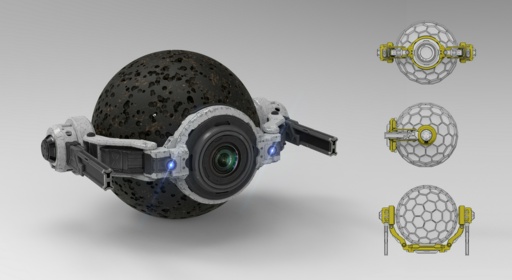CYBERNATION
3 alternative variants of combat (that were dismissed)
Alex Trofimov
08/12/2018 01:58

We came up with 8 variants of combat, one of which, our current one, I described in the previous post. We figured it will be also interesting to tell you about some of this 7 alternatives and why they were put aside in the end.
One looks like this: the turn is divided into 2 phases (movement and action), but all the players assign their orders simultaneously. First everyone plans the movement of the robots, presses «end phase» and see traces of all bots as they intend to relocate, their paths. No one can change their routes at this point.
Then the 2nd phase begins, where you choose the actions (shooting, throwing grenades, activating EMPs, mining resources). But here’s the kicker – as all the movement for the turn is already fixed and visible, you can act not only at the end of your movement, but at any point of it. There is a slider for the timeline of this turn, so you can rewind to the start of the movement and shoot from there. As you move the slider, all the bots on the field change their positions, step by step crawling forward or backwards on the planned path, as if you were manipulating a video.
For example, your bot passes a window on its way, and at the moment it glides by the window it sees enemy bot flying by on the other side of the wall – you shoot from this middle point in time, the only one, when you see each other through the window.
Then the second phase ends and all the planned actions play out – for real this time. It’s important to understand, that in this scenario everything players do as treated as «planning», entering commands into the bots, actions play for real only after the second phase, at the end of the turn. If 2 bots were going to the same spot – they will collide and fall, the rest of their planned actions will not play out. If your bot was killed at the start of the turn, he won’t do anything of what you had planned, so there is an incentive to act at the beginning of your movement, but from there you might have no vision of any enemy, so you will have to roll into position first.
In this variant any number of players can enter the match, and there is almost no downtime for anyone, as each phase takes place at the same time for everyone involved. Maybe you’ll have to wait a minute if you planned your actions faster than the clock ran out, but that’s it.
So yes, massive fights are viable with this variant, but we end up with a very convoluted system that is not transparent at all for the new players (I’m not even sure I succeeded in explaining it clearly). Yes, classic TB-combat is also not obvious, it sometimes contradicts logic and causality, but it’s a beast already known to the audience, hence – not that confusing. In our 2-phase variant there would be too much to digest, it’s hard to predict and adapt to.
Second variant also considered simultaneous actions of all players during each turn, but without division into phases of movement and shooting. You do all at once, but only for one bot at a turn (like in Worms). You don’t see any enemy movements and must work with their positions at the end of last turn.
You see 4 enemy bots and have to guess – which one enemy will choose for action. You can attack it to prevent from doing something dangerous, but you risk missing the shot, so attacking the other bots, who won’t move on this turn, is a safer bet.
When you press «end turn», both your and enemy bots try to act out your plan for them – move here, shoot this enemy. Actions play out in real time, so if you are shooting a moving target, weapons lead the shot, but you still can miss, because enemy can move out of range, go behind cover or just die of some other cause – to the third players shot for example. This variant is less convoluted (the phases are gone, the time slider is no more, you just pick a bot, assign actions and look, if they pay off), but still not transparent enough.
Third variant was much closer to classic TB combat (players act in turns, waiting for opponent to finish, not at the same time), with one exception – there can only be two teams. If the third party joins the fight, it can’t be independent and battle other 2, it must pick a side and join it, 2v1.
So if 100 players collide, they are divided into teams. The catch is that all the allies act simultaneously, while the enemy team waits and watches. You see all the movements of your friends in real time, you move with them, and when your Action Points are spent, you end the turn and wait for the enemy. As all 50 of your enemies act at the same time, you wait only for 1 turn (1-5 minutes), not for 99 consecutive turns (1-5 hours for all your allies and foes). This variant forces players into 2 teams, which can be badly balanced and create much less excitement than «everyone for himself» situation. You can collude in it as well (making 1v1v1 into a 2v1), but it requires additional efforts and coordination.
What do you think? Do you like any of these variants more than one we actually chose (described in previous post) or maybe you have a more elegant solution that we missed?
